The Impact of Proposition 1 in California on Human Services
As a human services organization in California, you’re likely closely following the developments around Proposition 1, the ballot measure that voters narrowly approved in March 2024. This proposition marks the most significant overhaul of the state’s mental health system in decades, and it will likely have major implications for how you deliver services and utilize funding.
In this article, we’ll discuss the key provisions of Prop 1 and what they mean for your organization. Hopefully, we’ll help you proactively adapt to the new human services landscape in California.
What Is Proposition 1?
Proposition 1, also known as the Behavioral Health Services Program and Bond Measure, was a ballot initiative in the March 2024 California primary election. The measure, which passed by a razor-thin margin of 50.2% to 49.8%, comprises two key components: Senate Bill 326 and Assembly Bill 531.
California’s Prop 1 initiative primarily involves the issuance of $6.38 billion in bonds to improve and expand the state’s mental health services. It represents one of the most significant statewide investments in managing the growing crisis of homelessness in California.
Key Provisions and Objectives of Proposition 1
The main provisions and objectives of Proposition 1 in California are as follows:
- It authorizes $6.38 billion in general obligation bonds to construct 11,150 new behavioral health treatment beds and housing units, plus 26,700 outpatient treatment slots; $1 billion is also specifically dedicated to homeless veterans’ housing initiatives.
- It shifts approximately $140 million annually from Mental Health Services Act (MHSA) funds away from counties and to the state government.
- It requires counties to spend around two-thirds of their MHSA funds on housing and support services for those with the most severe mental illnesses and substance use disorders, especially among the unhoused population. Currently, counties have more flexibility in how to allocate MHSA funds.
- It aims to prioritize getting people off the streets and into treatment facilities by expanding behavioral health housing and treatment capacity. Estimates suggest this could help tens of thousands of Californians per year.
Potential Impact on Funding and Resources
One of the most significant ways California’s Proposition 1 will impact human services organizations is in the allocation of funding, especially MHSA funds, which are a major source of behavioral health spending in the state. Here’s what you need to know.
Changes in Funding Allocation for Human Services
Under Prop 1, counties must spend a larger portion of their MHSA funds, around 65%, on housing and intensive support services for those with the most acute needs, including:
- Allocating 30% of their funds for housing support for people with a serious mental illness or substance use disorder
- Spending 35% of the funds on Full Service Partnerships (FSPs)
This means counties will have less control over their MHSA spending. Critics argue this could lead to cuts in other behavioral health services, like prevention, outreach, and existing treatment programs.
As a human services organization, you’ll likely need to adapt your budget and human resources to align with these MHSA changes. With less flexible MHSA funding, you may have to seek out other funding streams to maintain your service levels.
You might also need to build up your capacity and expertise in housing and comprehensive support services, which are now mandated to be a bigger focus of MHSA spending.
On the flip side, the $6.38 billion bond will inject a large amount of funding into the behavioral health system for capital projects. If you operate treatment facilities or supportive housing, this is great news for your organization. With Prop 1, you may be able to access some of these funds to expand your infrastructure through county grants.
Implications for Service Delivery
Beyond the fiscal impact, Prop 1 has major implications for how organizations deliver behavioral health services on the ground. Prop 1’s provisions will influence which populations and interventions are prioritized. Here’s a closer look.
Mental Health
Prop 1 places a strong emphasis on serving those with the most severe mental illnesses, particularly homeless people. Counties will have to direct more MHSA funds toward this population through housing and intensive support services.
As a provider, this means you may need to tailor more of your mental health programs for unhoused clients with complex needs. Evidence-based practices like assertive community treatment (ACT), critical time intervention (CTI), and supportive housing will likely become a larger part of your service mix.
At the same time, the shift in funding could result in less money for early intervention, prevention, and services for clients who are housed and have less acute needs. Agencies providing these services may face cuts if their counties can’t backfill the lost MHSA funding with other funds.
For example, in Orange County, there’s concern over Prop 1’s effects on local mental health funding. Some supervisors are concerned about the state getting more tax dollars, fearing it might cut funding for 50-plus county programs. Orange County is, thus, now trying to figure out ways to keep its services running despite the possible funding cuts.
Homelessness
Tackling the homeless crisis is an explicit goal of Prop 1. For organizations working on homelessness, this means an influx of funding for housing capital costs through the bond measure. Counties and continuums of care will have opportunities to apply for Prop 1 grants to acquire and rehabilitate properties like hotels or motels, as well as build new housing units.
Prop 1 specifies that housing projects should be paired with behavioral health treatment and support services to help people transition into permanent housing. Organizations that can provide this whole-person care and operate a housing program will be well-positioned.
However, some homeless advocates worry that Prop 1’s housing initiatives will be too heavily tied to institutional settings rather than true community-based housing.
Addiction
Expanding access to substance use disorder (SUD) treatment is another key goal of Prop 1. The bond measure will fund at least 6,800 new SUD treatment beds and 26,700 outpatient slots.
For SUD treatment providers, this could mean opportunities to grow their residential and outpatient programs, especially those that integrate mental health and housing. Organizations that offer multiple levels of care (e.g., detox, residential, sober living, outpatient) may have an advantage in competing for Prop 1 funds.
The state has indicated that Prop 1 will help expand the workforce as well. Behavioral health organizations may be able to tap into new pipelines of counselors and peer support specialists funded through the initiative.
Current Prop 1 Supporters
Prop 1 enjoys broad support from California’s Democratic establishment, as well as major players in the healthcare and business sectors. Supporters argue the measure is a critical step toward addressing the state’s homelessness and mental health crises.
Key supporters of Prop 1 include:
- Governor Gavin Newsom, who spearheaded the Prop 1 effort
- California’s Democratic legislative leadership, which passed the bills and placed Prop 1 on the ballot
- The California Hospital Association, California Chamber of Commerce, and other business groups
- Law-enforcement organizations like the California Police Chiefs Association
- Mental health advocates like the Steinberg Institute and National Alliance on Mental Illness (NAMI)
Supporters say Prop 1 will provide much-needed behavioral health infrastructure and refocus MHSA funds on Californians with the highest needs. They emphasize that the measure does not raise taxes but rather redirects existing MHSA funds.
Current Prop 1 Opponents
While Prop 1 has powerful backers, it has also drawn opposition from groups that argue it will undermine community-based care. Opponents include:
- Some county boards of supervisors warn that Prop 1 will lead to cuts in prevention and outreach programs.
- Disability rights advocates like Disability Rights California say Prop 1 incentivizes institutionalization over community living.
- Civil liberties groups like the American Civil Liberties Union (ACLU) oppose Prop 1’s potential expansion of involuntary treatment.
- The League of Women Voters argues that Prop 1 has flaws.
Opponents emphasize that while Prop 1’s goals around housing and treatment are laudable, they believe the measure is the wrong approach. They want to see more funding for upstream, voluntary services in the community.
Prepare for the Future Human Services Landscape Today
Proposition 1 will reshape behavioral health and homeless housing assistance efforts in California. While the long-term impact remains to be seen, it’s clear that human services organizations need to start adapting to the shifting priorities and funding streams today.
By understanding the key provisions of Prop 1 and how they intersect with your programs, you can position your organization to navigate the changes ahead. This may require rethinking your service mix, pursuing new funding opportunities, and forging new partnerships to deliver the housing and comprehensive care that will be in high demand.



